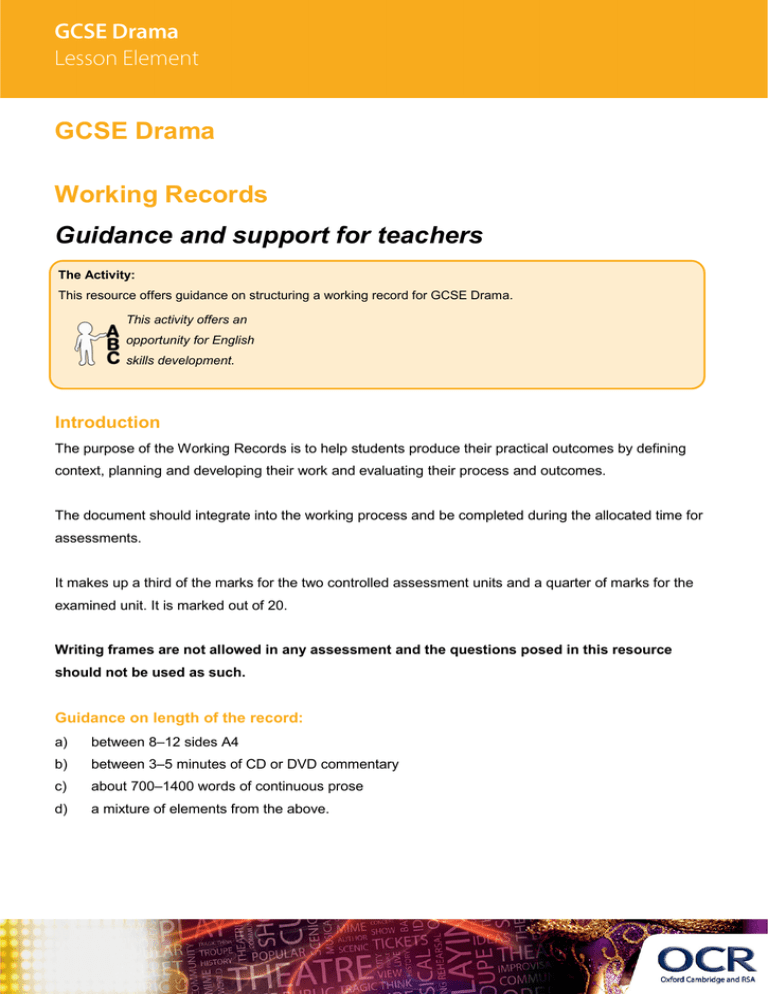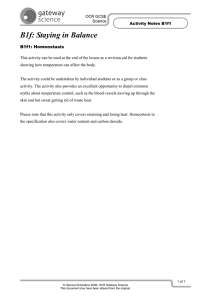GCSE Drama Lesson Element Teachers` Instructions
advertisement

GCSE Drama Working Records Guidance and support for teachers The Activity: This resource offers guidance on structuring a working record for GCSE Drama. This activity offers an opportunity for English skills development. Introduction The purpose of the Working Records is to help students produce their practical outcomes by defining context, planning and developing their work and evaluating their process and outcomes. The document should integrate into the working process and be completed during the allocated time for assessments. It makes up a third of the marks for the two controlled assessment units and a quarter of marks for the examined unit. It is marked out of 20. Writing frames are not allowed in any assessment and the questions posed in this resource should not be used as such. Guidance on length of the record: a) between 8–12 sides A4 b) between 3–5 minutes of CD or DVD commentary c) about 700–1400 words of continuous prose d) a mixture of elements from the above. Students should use subject specific terminology where it is suitable. Ensure students use the 1-hour set aside for both the Introduction and Evaluation. For A581 and A583 organise the WR in three clearly headed sections and for A582 five sections, Introduction, Item 1, Item 2, Item 3 and Final Evaluation. Key pitfalls • It does not help students fulfil the criteria for assessment well when completed solely as a retrospective document or when dominated by purely descriptive accounts of what was done. • Accounts of workshops done with the teacher in the preparation period are not needed. • There is no need to describe the plot although it may be relevant to analyse aspect of the plot to establish intent. • Often pages are not numbered. • To access the higher bands students will give clear reasons for decisions made and record formative evaluation as they rehearse and develop the performance/work. The structure of the Working Record Part 1 of the Working Record is an Introduction This section is a response to the text or stimulus being worked with. This will draw on information taught by the teacher and research done by the students in the preparation and exploration stages of the unit. Students have 1 hour to work on their introduction before starting their controlled assessment or examination time. From Page to Stage Key Questions to consider • What is the social, historical and cultural background to the text? • What are the particular artistic features of the text, the genre, and any implied performance style? • What is the background of the playwright? • Why have they chosen this particular extract for performance? Drama in the Making Key Questions to consider • What is the social, historical and cultural background of the stimulus? Does it have a defined background? • What possible drama scenarios, characters, potential dramatic tensions/conflicts might exist or be developed from the stimulus? (What are your initial ideas?) • What are the pros and cons of each initial idea? Which ones could be developed further? From Concept to Creation Key Questions to consider • The introduction will differ depending on which Brief is being explored. • For The Performer (text extract) Brief the key questions will be the same as A581. • For The Performer (devised) and The Deviser Brief it will be the same as A582. The Designer Brief Students should create a design concept as a starting point. • What are the particular artistic features of the text, the genre, and any implied performance style? • What period is it set/shall I set it? • What are the requirements of the text? (E.g. number of scene changes, locations etc.) Part 2 of the Working Record is the planning and development. This must be completed during the 10 hours of controlled assessment. Planning and development should chart the decisions made and the reasons behind them during the assessment. Formative evaluation should be included throughout the Working Record. Below is a suggested list of materials which could be included in this section. This is not an exhaustive list and students should include any evidence which has supported their planning and development. Not all evidence is suitable for all units/contexts. Planning • Rehearsal schedule to maximise time management • A ground plan of the acting area • Any costume, properties, lighting and sound preparation e.g. mood boards, cue sheet for lighting. • Ideas for improvisation and a drafted possible plot outline • Character development work Development • Ideas for playing the role • Costume designs • Record of properties, staging, sound and/or lighting used. • Research for design elements • Research of content/situation to develop stronger script • Analysis of the rehearsal process This evidence can be presented in a variety of ways, including: • Notes • Diagrams • Sketches • CD or DVD evidence • Continuous writing • Storyboards • Scenarios • Photographs • Drawings • Excerpts of dialogue • Designs • Character notes Part 3 of the Working Record is the Final Evaluation This is the final summative assessment. This should be analytical and evaluative and avoid being descriptive. They also need to include an evaluation of another groups work for both controlled assessment units. Students have 1 hour for this evaluation after the 10 hours of controlled assessment or examination time is completed. Effective evaluations • Students need to reference what they have written in the Introduction. • How successful was the project/performance? • What areas need further development or re-thinking? • Page to Stage: How well they have met the intentions of the playwright and the needs of the text? • Drama in the Making: How can the items be turned into an engaging play? What is the future potential? How can this be realised? • Concept to Creation: How effective is the work against the needs of the chosen Brief and the intentions established in the Introduction? The students can receive feedback from the teacher and peers after their dress run (Design and Deviser students also run through their presentation). This feedback they can use and respond to in the Final Evaluation. The Final Evaluation should not be a re-cap of evaluation already made in the record. To give us feedback on, or ideas about the OCR resources you have used, email resourcesfeedback@ocr.org.uk OCR Resources: the small print OCR’s resources are provided to support the teaching of OCR specifications, but in no way constitute an endorsed teaching method that is required by the Board, and the decision to use them lies with the individual teacher. Whilst every effort is made to ensure the accuracy of the content, OCR cannot be held responsible for any errors or omissions within these resources. © OCR 2014 - This resource may be freely copied and distributed, as long as the OCR logo and this message remain intact and OCR is acknowledged as the originator of this work. OCR acknowledges the use of the following content: Maths icon: Air0ne/Shutterstock.com


